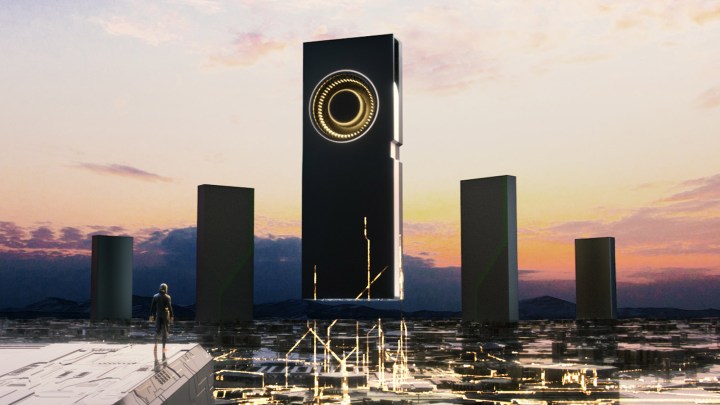
At its virtual GPU Technology Conference 2021, Nvidia unveiled its next-generation GPUs for creators. Part of the RTX Studio lineup, the new graphics cards are for creators on laptops, workstations, and desktops. A total of eight new GPUs were announced that are based on the Ampere graphics architecture that’s found on the gaming GeForce RTX 3000 series.
On the desktop, Nvidia expanded its creative portfolio by introducing the Nvidia RTX A5000 and RTX A4000 cards. The company stated that the cards feature new RT cores, Tensor cores, and CUDA cores optimized for A.I., graphics, and real-time rendering. The new architecture makes these new cards up to twice as fast as prior generation offerings.
These include second-generation RT cores that deliver up to two times the throughput of the prior generation to run concurrent ray tracing, shading, and denoting tasks along with third-generation Tensor cores and CUDA cores. The CUDA cores deliver up to 2.5x the FP32 performance compared to prior generations.
The desktop GPUs will ship with up to 24GB of video memory, and all the cards ship with GDDR6 RAM. The RTX A4000 ships with 16GB of memory, twice as much as the previous generation, while the RTX A5000 will ship with 24GB of GDDR6 memory, though you can double that with Nvidia NVLink to connect two GPUs. All the desktop cards support PCIe Gen 4, which delivers double the bandwidth of the prior generation, and this is important for data-intensive tasks that are important for work in A.I., 3D modeling, and data analysis.

“Speed is everything when we need to evaluate new concepts for the most adventurous vehicles, and the NVIDIA RTX A5000 really delivers what we need,” CGI lead Erick Green at Polaris, a manufacturer of motorcycles and ATVs, said. “The basic viewport rendering is incredibly fast in Octane Render — 5x faster — and unlocks things we couldn’t have even tried before.”
The RTX 5000 desktop card sports 28.3 billion transistors on an 8N node made by Samsung. It has 64 RT cores, 256 Tensor cores, and 8,192 CUDA cores. The RT performance of this card is measured at 54.2 TFLOPs, according to Nvidia. Maximum power consumption is 230W. The RTX 4000 supports 17.4 billion transistors and comes with 48 RT cores, 192 Tensor cores, and 6,144 CUDA cores on the same 8N node. The maximum power consumption is 140W.
RTX Studio Laptops

On laptops, Nvidia unveiled its RTX A2000, RTX A3000, RTX A4000, and RTX A5000 series mobile graphics cards. RTX Studio Lap[tops will also include the latest Max-Q designs combined with the latest RTX graphics technologies, according to Nvidia. The laptops support third-get Max-Q technology, allowing the systems to be thin and light. These laptops come with Dynamic Boost 2.0, WhisperMode 2.0, and Resizable Bar technologies. The laptops support up to 16GB of video memory.
The RTX A5000 laptop graphics comes with 6,144 CUDA cores, 192 Tensor cores, and 48 RT cores. Nvidia’s stated power consumption for this card ranges from 80 to 165W. The card comes with 16GB of GDDR6 memory, and its RT core performance is rated at 75.6 TFLOPs.
The RTX A4000 mobile GPU has 5,120 CUDA cores, 160 Tensor cores, and 40 RT cores. The RTX A3000 mobile GPU supports 4,096 CUDA cores, 128 Tensor cores, and 32 RT (ray tracing) cores. And the RTX A2000 mobile GPU supports 2,560 CUDA cores, 80 Tensor cores, and 20 RT cores. The entry-level card has a maximum power consumption rated between 35 to 95W.
Additionally, Nvidia also announced updates to the Turing architecture that preceded the current Ampere generation. New Nvidia T1200 and T600 laptops were also unveiled that are based on Turing.
In data centers, Nvidia announced its new Nvidia A10 and A16 GPUs. “The A10 provides up to 2.5x the virtual workstation performance of previous generation for designers and engineers, while the A16 GPU provides up to 2x user density with lower total cost of ownership and an enhanced virtual desktop infrastructure experience over the previous generation,” the company claimed.
Nvidia’s latest RTX desktop and data center GPUs will be available from partners later this month, while the RTX Studio Laptops will become available globally in the second quarter of the year.



